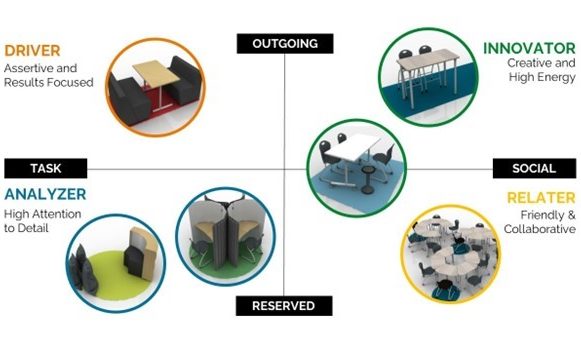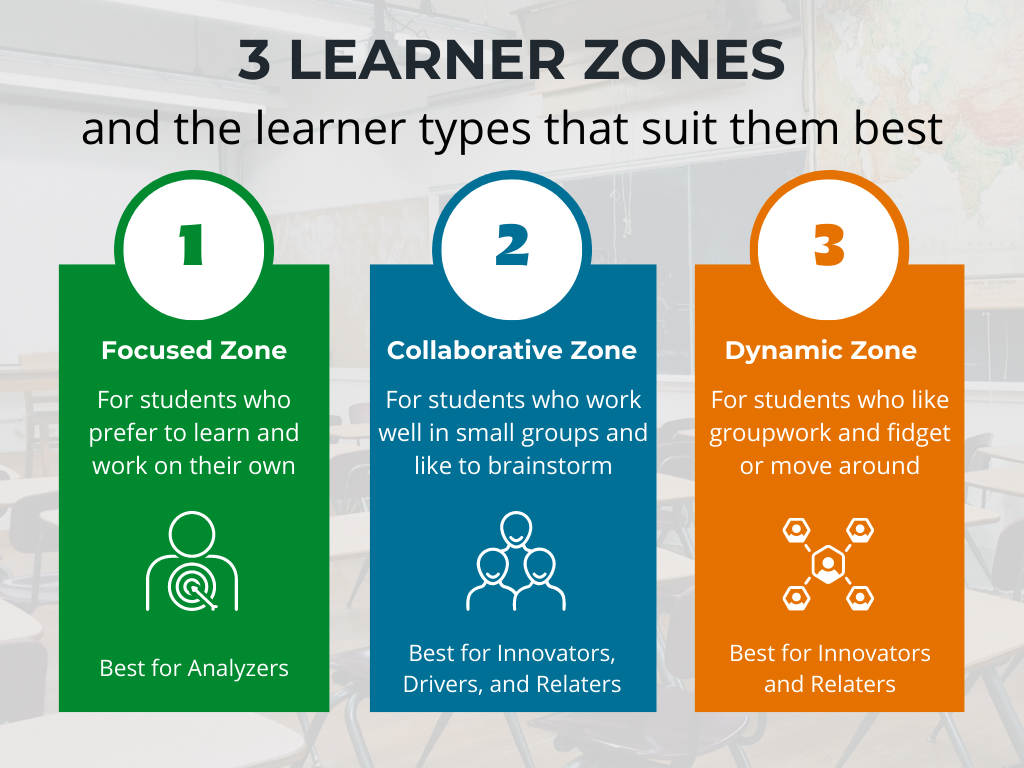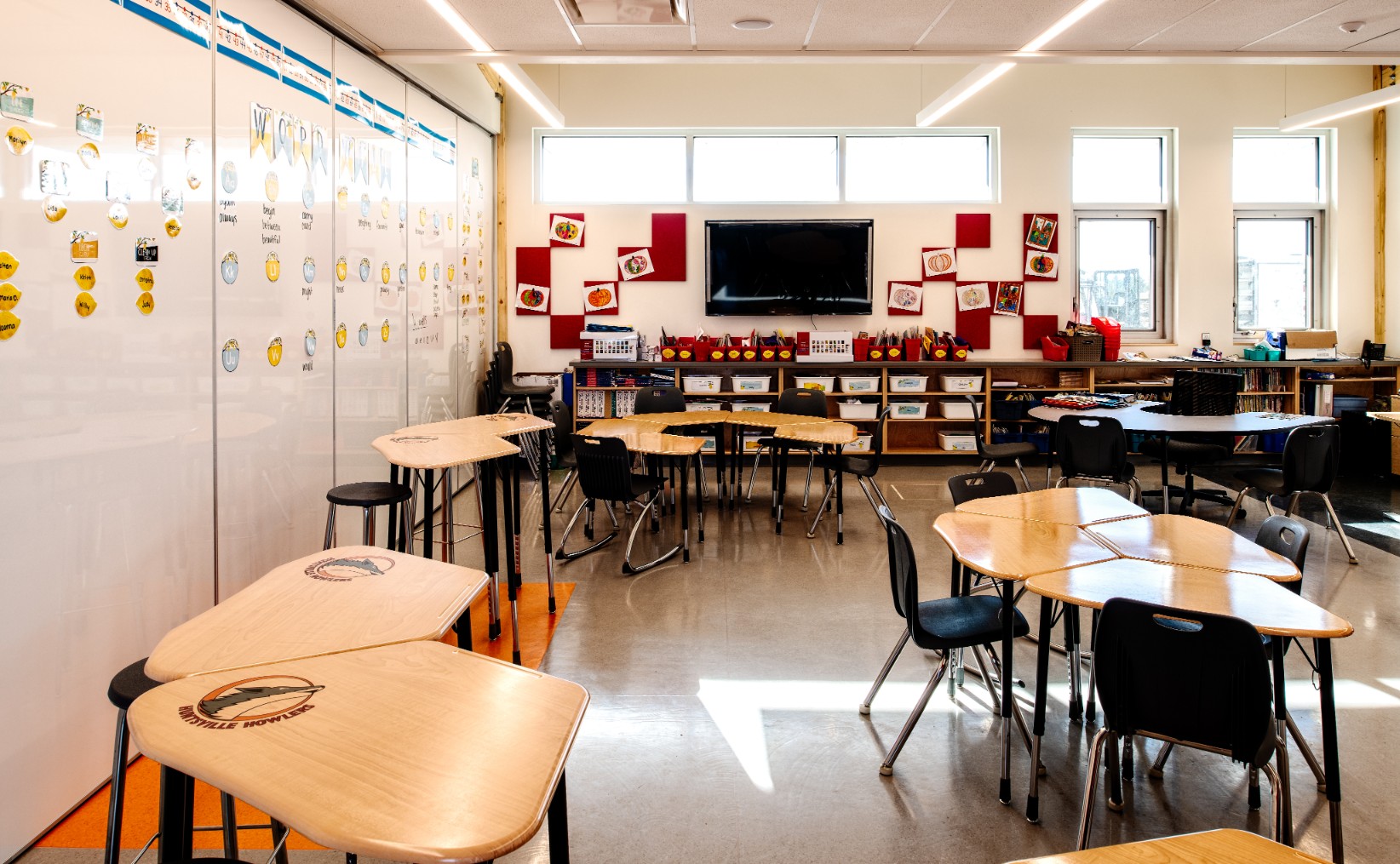How to Use Learning Styles to Set Students Up for Success
June 3, 2022


Do you consider yourself an introvert or an extrovert? Do you notice that you have preferred ways of intaking information, collaborating, and communicating? We are each unique in the way we learn, interact, and communicate, and this is largely based on differences in our personalities. As such, we cannot expect each student to learn the same way or even in the same environment. Every student in a classroom is an individual and falls into one of four learner types, and each type does best in a distinct learning zone or environment.
The Four Learner Types
- Analyzer: These students have excellent attention to detail and like to work independently without any distractions or disruptions. Analyzers are self-reliant and do best in quiet spaces because they can concentrate and focus.
- Innovator: These learners are creative and high-energy. When you think of students who can’t sit still, are always on the move, and like making things with their hands, they are likely an Innovator. They get bored quickly and need constant stimulation to stay focused.
- Driver: The Driver is an independent student who works well with those who need encouragement or help with a particular subject. If you have two Drivers working in the same group, they will often struggle because they both want to be in control. As the name suggests, they like to be the driving force.
- Relater: These learners are fantastic collaborators. They are generally liked by everyone, work great in groups, and love being part of a team. Relaters want everyone to feel included and do their best to ensure everyone succeeds.

Learning Zones in the Classroom

- Focused Zone: This zone provides a space where students who prefer to work individually can focus, complete self-study activities, or take time away from the business of a classroom in a quiet corner. The zone often includes single-seat desks, learning pods, or partitioning to create a separated quiet space.
- This zone is best for the Analyzer learner type.
- Collaborative Zone: This zone is for students who work well in groups. Here you will find furniture solutions and setups where multiple students can sit to brainstorm and work together on tasks. Round tables, individual desks grouped together, and standing desks all help foster a space where students can collaborate.
- This zone is best for the Innovator, Driver, and Relater learner types.
- Dynamic Zone: This zone is generally the largest zone in the classroom, promoting healthy movement for all students to improve focus and concentration. These zones often include furniture pieces that encourage movement, like rocking chairs, wobble stools, or stand-up desks, allowing students to move or fidget quietly as they absorb content and instruction.
- This zone is best for the Innovator and Relater learner types.
The Student-Centred Classroom
Setting up the Classroom to Support All Learning Types
It’s important to note that learner types are not always static. They can be fluid and change depending on several factors, including the time of day, the student’s current emotional state, and even the subject being taught. Therefore, it’s essential to design your classroom with flexibility in mind so students can move between zones, finding a seating (or standing) arrangement that best suits their learning style at that moment in time.
You may find single-seat desks and chairs at the front of a balanced classroom, but as you move to the back, the room is more collaborative, with tables where multiple students can sit. A balanced (or student-centred) classroom recognizes that no two students are the same and is designed with each type of learner in mind.

Here are some quick tips and tricks to easily set up a zoned classroom:

- Create an active area and a quiet area.
- Use individual desks in the classroom that can be arranged in a variety of formations.
- Arrange desks in a circular shape to promote collaboration.
- Put long tables at the back of the room.
- Have various seating options.
- Look for items like cabinets or bookcases to use as stand-up areas or as room dividers.
- Clear an area for students that like working on the floor.
- Keep high-traffic areas free of congestion.
- Use empty wall space as a bulletin board or presentation zone.
- Consider a mobile teacher’s desk so you can instruct from anywhere in the classroom.
Use Classroom Design to Foster Learning
Ultimately, it’s easier to teach students in a balanced, student-centred classroom because they are far more likely to be engaged in learning. Classrooms should be flexible so they can be moved around to meet the needs of every student and educator. We have classroom consultants and designers who deeply understand the impact that a well-designed classroom can have on student engagement and success. They can take your current classroom and transform it into a functional and aesthetically pleasing space where students thrive and reach their full potential. Reach out today to learn more.
Check out these blogs if you want to learn about how our classroom designs directly benefit students:
The 3 Key Steps to Creating a Student-Centred Classroom

